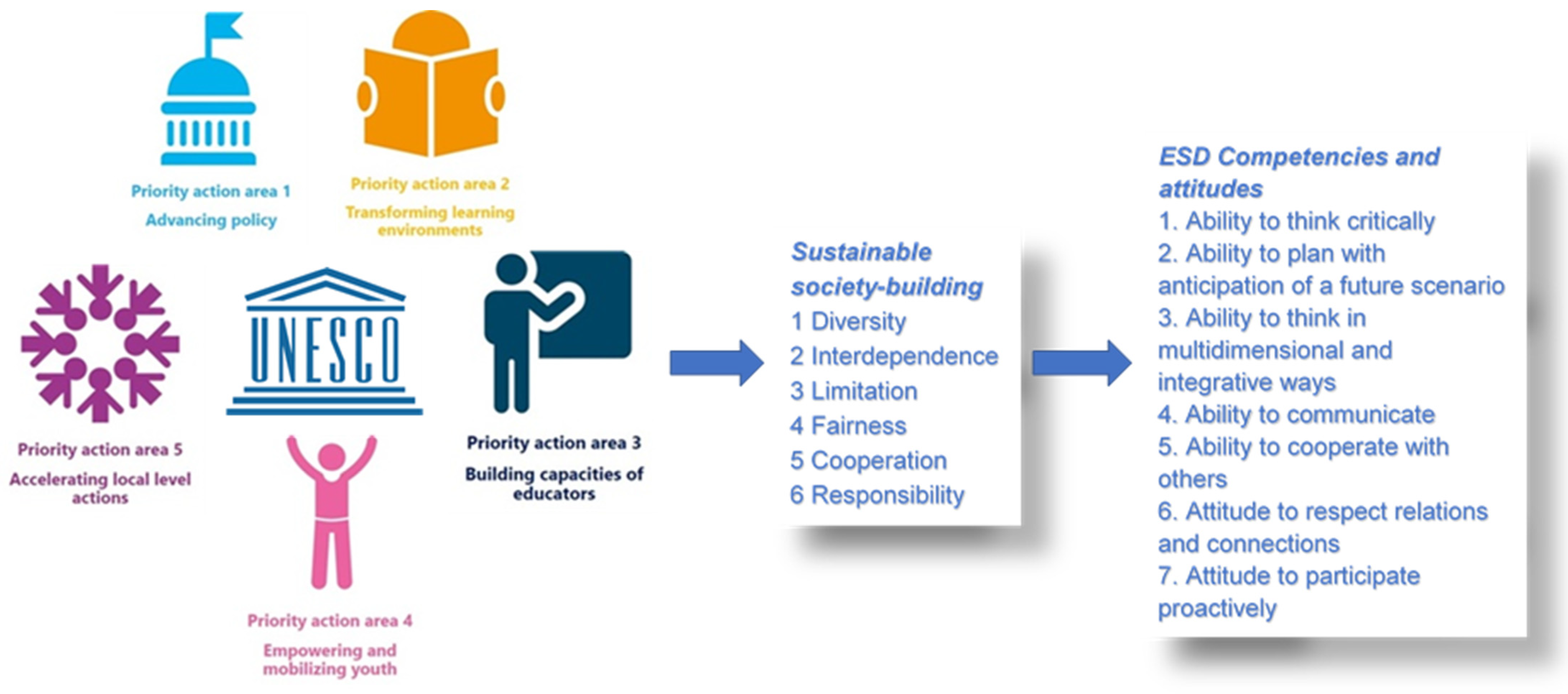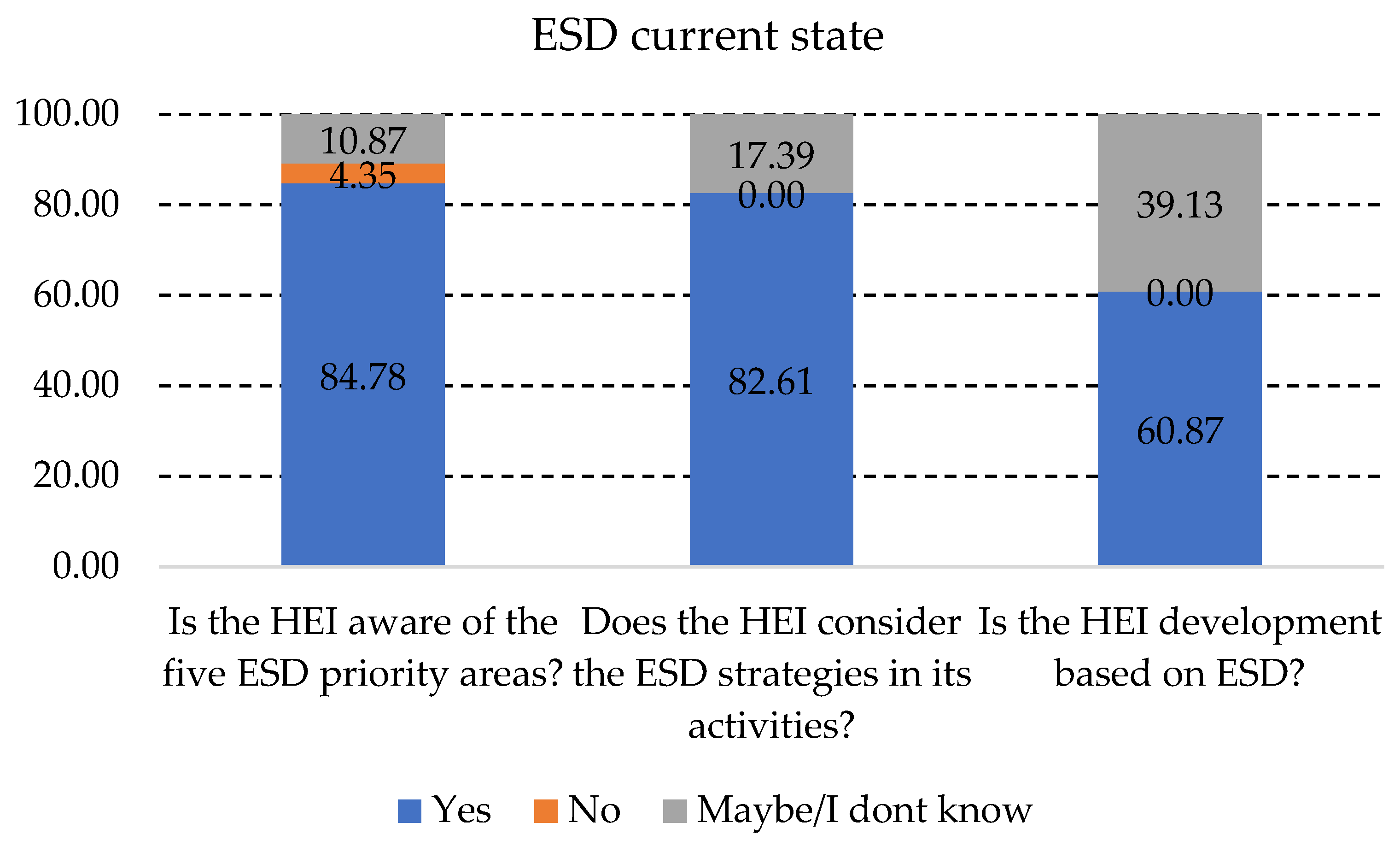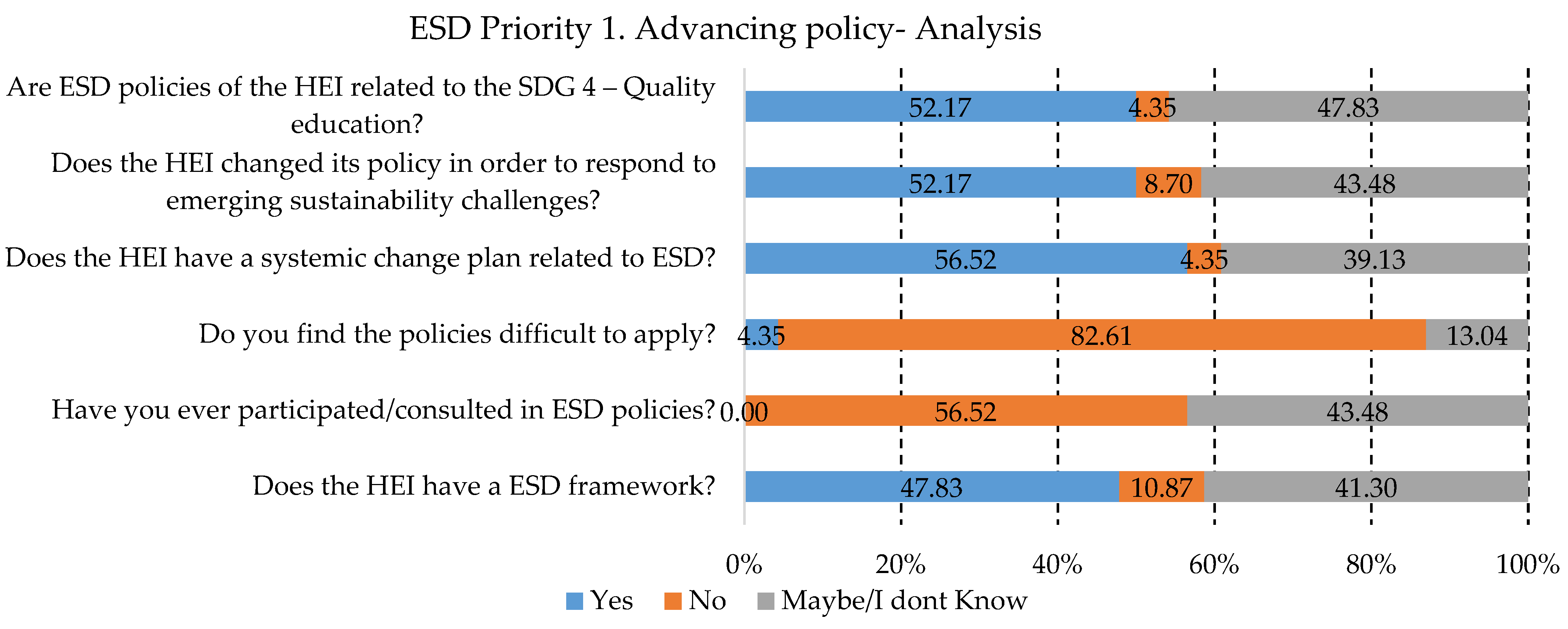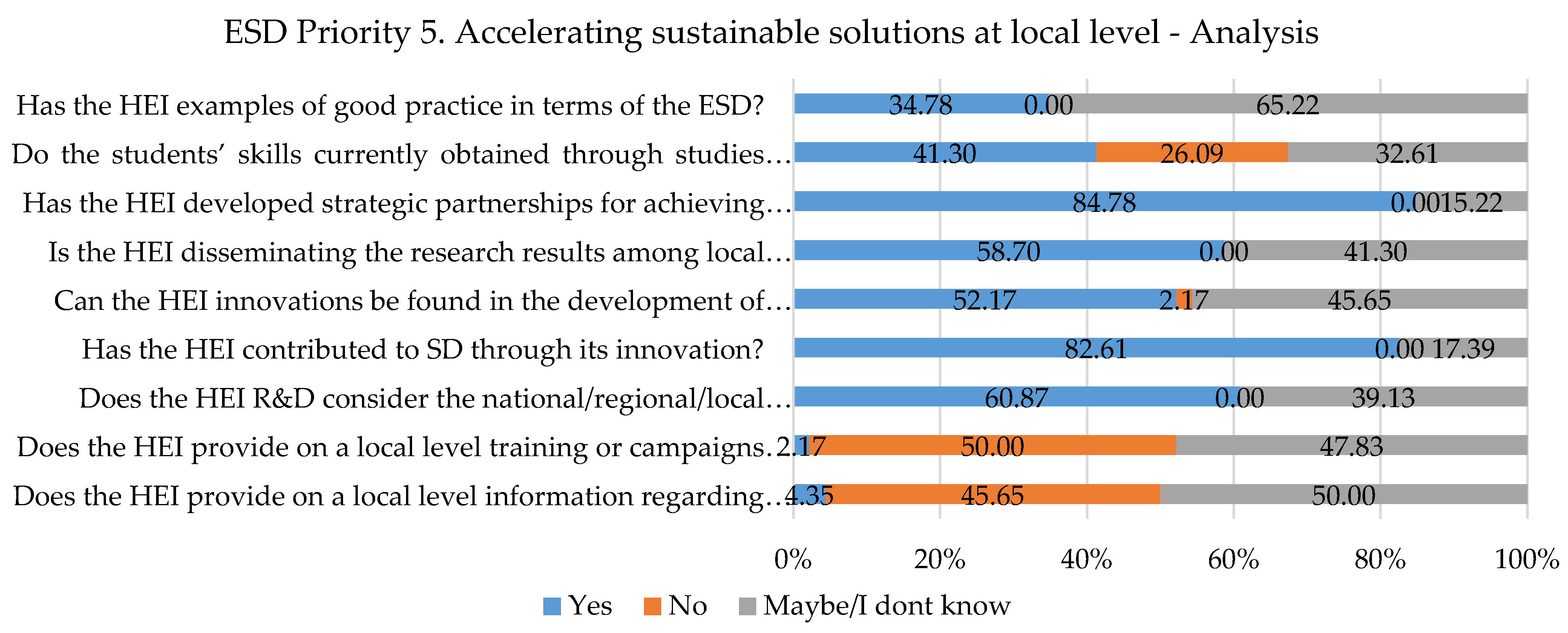Analysis of UNESCO ESD Priority Areas’ Implementation in Romanian HEIs
Abstract
1. Introduction
2. Literature Review
2.1. Education for Sustainable Development in Time
2.2. Implementing ESD: The Great Outcome
2.3. Higher Education Institutions (HEIs) and ESD
3. Materials and Methods
3.1. Research Methodology and Data Gathering
3.2. Interview Design
3.3. Study Limitations
4. Results
RHEI5: “The HEI is acting in the direction of sustainable development. We are at the start of a department development that will be responsible for overseeing the implementation of policies, awareness campaigns, activities for teachers and students, that can all contribute to ESD.”
RHEI23: “Although we did not have a dedicated structure for sustainable development, we tackled these issues in every management plan developed for the university, and on top we changed and we are still in the process of changing some inside policies that can only lead to future development”
RHEI37: “We are taking some steps in the area of sustainable development, and we started this process through becoming a part of a consortium that can mean a good practice example, because through meeting/project, we can bring closer the element that can contribute to achieving the goals for every priority”.
RHEI16: “A desire for a new teaching environment or to adopt another teaching method was expressed by our younger teaching staff. They mentioned the need for upgrading the environment that can also fulfill the needs of the socio-economic domain.”
RHEI41: “When you try to change the teaching environment of a professor, is like you are diminishing his entire life’s work. Most of the time, unfortunately, they do not see it as an evolution, but rather as a step back, and not just this, but as way of saying we don’t need you anymore.”
RHEI8: “Although most of us use electronic devices every day, this does not mean that everybody knows how to use them. In our HEI, a need for digital skills development which is on our short-term goals has been identified.”
RHEI19: “I am sorry to say this, but during the COVID-19 pandemic most of the teachers started using for the first time an e-learning platform, which was highly reflected in the quality of the teaching process. There were cases where everything would work just as it should have, but there were cases where it required training and even then, there still were elements unknown.”
RHEI26: “I don’t think that the HEI alone will succeed in reaching the goals of the five priority areas, this can be possible just together with other leading authorities”
RHEI33: “The Education Ministry should clearly contribute to the objectives set for education regarding sustainable development. Not just that, but emerging trades should be taken into consideration when trying to improve the curriculum. Also, the business environment should be a part of this transformation, together with specialists from the socio-economic environment.”
5. Discussion
6. Conclusions
Supplementary Materials
Author Contributions
Funding
Institutional Review Board Statement
Informed Consent Statement
Data Availability Statement
Conflicts of Interest
References
- United Nations. Transforming Our World: The 2030 Agenda for Sustainable Development; United Nations: New York, NY, USA, 2015.
- United Nations. Sustainable Development Report 2022. From Crisis to Sustainable Development: The SDGs Roadmap to 2030 and Beyond; Cambridge University Press: Cambridge, UK, 2022. [Google Scholar]
- Leicht, A.; Heiss, J.; Byun, W.J. Issues and Trends in Education for Sustainable Development; UNESCO Publishing: Paris, France, 2018; Volume 5. [Google Scholar]
- Unpacking Sustainable Development Goal 4: Education 2030. Guide—UNESCO Digital Library. Available online: https://unesdoc.unesco.org/ark:/48223/pf0000246300 (accessed on 30 August 2022).
- European Commission. Directorate-General for Education, Youth, Sport and Culture, Education and Training Monitor 2019. Available online: https://ec.europa.eu/education/sites/education/files/document-library-docs/volume-1-2019-education-and-training-monitor.pdf (accessed on 30 August 2022).
- Format for Reporting on Implementation of the UNECE Strategy for Education for Sustainable Development Phase III: 2011–2015. Available online: https://www.unece.org/fileadmin/DAM/env/esd/10thMeetSC/Documents/Czech_Republic.pdf (accessed on 31 August 2022).
- Format for Reporting on Implementation of the UNECE Strategy for Education for Sustainable Development within the Framework of the United Nations Decade of Education for Sustainable Development (2005–2014). Available online: https://www.unece.org/fileadmin/DAM/env/esd/Implementation/NIRs2010/6%20Denmark.pdf (accessed on 31 August 2022).
- Format for reporting on the Implementation of the UNECE Strategy for Sustainable Development (2017–2019). Available online: https://www.unece.org/fileadmin/DAM/env/esd/Implementation/NIR_2018/Estonian_ESD_NIR_final_2019.pdf (accessed on 27 July 2022).
- Finnish National Board of Education. National Core Curriculum for Basic Education; National Board of Education: Helsinki, Finland, 2014. [Google Scholar]
- Finland’s Ten Year Strategy and Guidelines 2006–2014 for Education for Sustainable Development. Available online: https://docplayer.net/18312677-Finland-s-ministry-of-education-a-national-strategy-and-guidelines-2006-2014-for-education-for-sustainable-development.html (accessed on 28 July 2022).
- Finland Reporting on the Implementation of the UNECE Strategy for Education for Sustainable Development (2017–2019). Available online: https://www.unece.org/fileadmin/DAM/env/esd/Implementation/NIR_2018/Finland_NIR_2018.pdf (accessed on 28 July 2022).
- Collectif Pour l’Intégration de la Responsabilité Sociétale et du Développement Durable Dans l’Enseignement Supérieur (CIRES). Available online: https://www.cirses.fr/ (accessed on 27 July 2022).
- Rapport 2010 Sur La Mise En Oeuvre de la Stratégie de la Cee Pour L’éducation en vue du Développement Durable. Available online: https://www.unece.org/fileadmin/DAM/env/esd/Implementation/NIRs2010/34%20France.pdf (accessed on 27 July 2022).
- UNECE–10 Years of UNECE Strategy for Education for Sustainable Development. Available online: https://unece.org/DAM/env/esd/ESD_Publications/10_years_UNECE_Strategy_for_ESD.pdf (accessed on 28 July 2022).
- Higgins, P.; Scott, W.; Dillon, J.; Peters, C. Education for Sustainable Development (ESD) in the UK-Current Status, Best Practice and Opportunities for the Future. Available online: https://www.researchgate.net/publication/336086683 (accessed on 20 August 2022).
- Olsson, D.; Gericke, D.; Rundgen Chang, S.-N. The Effect of Implementation of Education for Sustainable Development in Swedish Compulsory Schools—Assessing Pupils’ Sustainability Consciousness. Environ. Educ. Res. 2016, 22, 176–202. [Google Scholar] [CrossRef]
- Economic Commision, for Europe. United Nations Decade of Education for Sustainable Development (2005–2014) Good Practices in the UNECE Region Education for Sustainable Development in Action Good Practices N°2—2007UNESCO Education Sector. Available online: https://unesdoc.unesco.org/in/documentViewer.xhtml?v=2.1.196&id=p::usmarcdef_0000153319&file=/in/rest/annotationSVC/DownloadWatermarkedAttachment/attach_import, (accessed on 29 July 2022).
- Franco, I.; Saito, O.; Vaughter, P.; Whereat, J.; Kanie, N.; Takemoto, K. Higher Education for Sustainable Development: Actioning the Global Goals in Policy, Curriculum and Practice. Sustain. Sci. 2018, 14, 1621–1642. [Google Scholar] [CrossRef]
- Meschede, C. The Sustainable Development Goals in Scientific Literature: A Bibliometric Overview at the Meta-Level. Sustainability 2020, 12, 4461. [Google Scholar] [CrossRef]
- UNESCO. Intergovernmental Conference on Environmental Education; UNESCO: Paris, France, 1977. [Google Scholar]
- Ndiaye, A.; Khushik, F.; Diemer, A.; Pellaud, F. Environmetal Education for Sustainable Development: Challenges and Issues. Int. J. Humanit. Soc. Sci. 2019, 9. [Google Scholar] [CrossRef]
- Education for Sustainable Development: A Critical Reflexive Discourse on a Transformative Learning Activity for Business Students. Available online: https://link.springer.com/article/10.1007/s10668-022-02335-1 (accessed on 29 July 2022).
- Bonnett, M. Education for Sustainability as a frame of mind. Environ. Educ. Res. 2002, 8, 9–20. [Google Scholar] [CrossRef]
- UNESCO. Education for Sustainable Development: A Roadmap; UNESCO: Paris, France, 2020. [Google Scholar]
- Imara, K.; Altinay, F. Integrating Education for Sustainable Development Competencies in Teacher Education. Sustainability 2021, 13, 12555. [Google Scholar] [CrossRef]
- Kromydas, T. Rethinking higher education and its relationship with social inequalities: Past knowledge, present state and future potential. Palgrave Commun. 2017, 3, 1. [Google Scholar] [CrossRef]
- Rashid, L. Entrepreneurship Education and Sustainable Development Goals: A literature Review and a Closer Look at Fragile States and Technology-Enabled Approaches. Sustainability 2019, 11, 5343. [Google Scholar] [CrossRef]
- Momete, D.C.; Momete, M.M. Map and Track the Performance in Education for Sustainable Development across the European Union. Sustainability 2021, 13, 13185. [Google Scholar] [CrossRef]
- Klemeš, J.J.; Villas Bôas de Almeida, C.M.; Wang, Y. Advancing Higher Education for Sustainable Development: International Insights. J. Clean. Prod. 2013, 48, 3–9. [Google Scholar]
- Sinakou, E.; Boeve-de Pauw, J.; Goossens, M.; Van Petegem, P. Academics in the field of Education for Sustainable Development: Their conceptions of Sustainable Development. J. Clean. Prod. 2018, 184, 321–332. [Google Scholar] [CrossRef]
- Kopnina, H. Education for Sustainable Development Goals (ESDC): What is Wrong with ESDGs, and What Can We Do Better. Educ. Sci. 2020, 10, 261. [Google Scholar] [CrossRef]
- Kioupi, V.; Voulvoulis, N. Education for Sustainable Development: A Systemic Framework for Connecting the SDGs to Educational Outcomes. Sustainability 2019, 11, 6104. [Google Scholar] [CrossRef]
- Mandela, N. Lighting Your Way to a Better Future. Speech Delivered by Mr N R Mandela at Launch of Mindset Network Planetarium, University of the Witwatersrand Johannesburg South Africa. 16 July 2003. Available online: https://db.nelsonmandela.org/speeches/pub_view.asp?pg=item&ItemID=NMS909 (accessed on 9 July 2022).
- Chankseliani, M.; McCowan, T. Higher education and the Sustainable Development Goals. High. Educ. 2021, 81, 1–8. [Google Scholar] [CrossRef] [PubMed]
- Owens, T.L. Higher education in the sustainable development goals framework. Eur. J. Educ. 2017, 52, 414–420. [Google Scholar] [CrossRef]
- Bessant, S.E.F.; Robinson, Z.P.; Ormerod, R.M. Neoliberalism, new public management and the sustainable development agenda of higher education: History, contradictions and synergies. Environ. Educ. Res. 2015, 21, 417–432. [Google Scholar] [CrossRef]
- Williams, O.; Swierad, E.M. A Multisensory Multilevel Health Education Model for Diverse Communities. Int. J. Environ. Res. Public Health 2019, 16, 872. [Google Scholar] [CrossRef]
- Giesenbauer, B.; Müller-Christ, G. University 4.0: Promoting the Transformation of Higher Education Institutions toward gSustainable Development. Sustainability 2020, 12, 3371. [Google Scholar] [CrossRef]
- Filho, W.L. (Ed.) Implementing Sustainability in the Curriculum of Universities. Approaches, Methods and Projects. World Sustainability Series (WSUSE); Springer: Berlin/Heidelberg, Germany, 2018; p. 330. [Google Scholar]
- Willats, J.; Erlandsson, L.; Molthan-Hill, P.; Dharmasasmita, A.; Simmons, E. A University Wide Approach to Embedding the Sustainable Development Goals in the Curriculum—A Case Study from the Nottingham Trent University’s Green Academy. In Implementing Sustainability in the Curriculum of Universities; Filho, W.L., Ed.; World Sustainability Series; Springer: Cham, Switzerland, 2018; pp. 63–78. [Google Scholar] [CrossRef]
- Cebrián, G. The I3E model for embedding education for sustainability within higher education institutions. Environ. Educ. Res. 2018, 24, 153–171. [Google Scholar] [CrossRef]
- Hill, L.M.; Wang, D. Integrating sustainability learning outcomes into a university curriculum: A case study of institutional dynamics. Int. J. Sustain. High. Educ. 2018, 19, 699–720. [Google Scholar] [CrossRef]
- Haigh, M. Greening the university curriculum: Appraising an international movement. J. Geogr. High. Educ. 2005, 29, 31–48. [Google Scholar] [CrossRef]
- Nomura, K.; Abe, O. Higher education for sustainable development in Japan: Policy and progress. Int. J. Sustain. High. Educ. 2010, 11, 120–129. [Google Scholar] [CrossRef]
- Milutinović, S.; Nikolić, V. Rethinking higher education for sustainable development in Serbia: An assessment of Copernicus charter principles in current higher education practices. J. Clean. Prod. 2014, 62, 107–113. [Google Scholar] [CrossRef]
- Lu, S.; Zhang, H.-S. A comparative study of education for sustainable development in one British university and one Chinese university. Int. J. Sustain. High. Educ. 2014, 15, 48–62. [Google Scholar] [CrossRef]
- Washington-Ottombre, C.; Bigalke, S. An aggregated and dynamic analysis of innovations in campus sustainability. Int. J. Sustain. High. Educ. 2018, 19, 353–375. [Google Scholar] [CrossRef]
- Mendoza, J.M.F.; Gallego-Schmid, A.; Azapagic, A. A methodological framework for the implementation of circular economy thinking in higher education institutions: Towards sustainable campus management. J. Clean. Prod. 2019, 226, 831–844. [Google Scholar] [CrossRef]
- Sima, M.; Grigorescu, I.; Bălteanu, D. An overview of campus greening initiatives at universities in Romania. Int. J. Sustain. High. Educ. 2019, 20, 410–422. [Google Scholar] [CrossRef]
- Merma-Molina, G.; Gavilán-Martín, D.; Baena-Morales, S.; Urrea-Solano, M. Critical Thinking and Effective Personality in the Framework of Education for Sustainable Development. Educ. Sci. 2022, 12, 28. [Google Scholar] [CrossRef]
- Baena-Morales, S.; Ferriz-Valero, A.; Campillo-Sánchez, J.; González-Víllora, S. Sustainability Awareness of In-Service Physical Education Teachers. Educ. Sci. 2021, 11, 798. [Google Scholar] [CrossRef]
- Rieckmann, M. Future-oriented Higher Education: Which Key Competences Should Be Fostered through University Teaching and Learning? Futures 2012, 44, 127–135. [Google Scholar] [CrossRef]
- Lambrechts, W.; Mulà, I.; Ceulemans, K.; Molderez, I.; Gaeremynck, V. The integration of Competences for Sustainable development in Higher Education: An Analysis of bachelor Programs in Management. J. Clean. Prod. 2013, 48, 65–73. [Google Scholar] [CrossRef]
- Lozano, R.; Merril, M.; Sammalisto, K.; Ceulemans, k.; Lozano, F. Connecting Competences and Pedagogical Approaches for Sustainable Development in Higher Education: A Literature Review and Framework Proposal. Sustainability 2017, 9, 1889. [Google Scholar] [CrossRef]
- Wiek, A.; Withycombe, L.; Redman, C.L. Hey Competencies in Sustainability. A Reference Framework for Academic Program Development. Sustain. Sci. 2018, 6, 203–218. [Google Scholar] [CrossRef]
- Cebrián, G.; Junyent, M.; Mulà, I. Competencies in Education for Sustainable Development: Emerging Teaching and Research Developments. Sustainability 2020, 12, 579. [Google Scholar] [CrossRef]
- Findler, F.; Schönherr, N.; Lozano, R.; Stacherl, B. Assessing the Impacts of Higher Education Institutions on Sustainable Development—Analysis of Tools and Indicators. Sustainability 2019, 11, 59. [Google Scholar] [CrossRef]
- Findler, F.; Schönherr, N.; Lozano, R.; Reider, D.; Martinuzzi, A. Conceptualizing Sustainable Development Impacts on Higher Education Institutions. Int. J. Sustain. High. Educ. 2019, 20, 23–38. [Google Scholar] [CrossRef]
- Boca, G.D.; Saraçli, S. Environmental education and student’s perception, for sustainability. Sustainability 2019, 11, 1553. [Google Scholar] [CrossRef]
- Urquidi-Martín, A.C.; Tamarit-Aznar, C.; Sánchez-García, J. Determinants of the Effectiveness of Using Renewable Resource Management-Based Simulations in the Development of Critical Thinking: An Application of the Experiential Learning Theory. Sustainability 2019, 11, 5469. [Google Scholar] [CrossRef]
- Lazzarini, B.; Pérez-Foguet, A.; Boni, A. Key characteristics of academics promoting Sustainable Human Development within engineering studies. J. Clean. Prod. 2018, 188, 237–252. [Google Scholar] [CrossRef]
- Sinden, C.K. Incorporating Sustainability into the Academic Institution. Reinvention Int. J. Undergrad. Res. 2021, 14, 1. [Google Scholar] [CrossRef]
- Lozano, R.; Ceulemans, K.; Alonso-Almeida, M.; Huisingh, D.; Lozano, F.J.; Waas, T.; Lambrechts, W.; Lukman, R.; Hugé, J. A review of commitment and implementation of sustainable development in higher education: Results from a worldwide survey. J. Clean. Prod. 2015, 108, 1–18. [Google Scholar] [CrossRef]
- Farinha, C.; Caeiro, S.; Azeiteiro, U. Universities speak up regarding the implementation of sustainable development challenges. Int. J. Sustain. High. Educ. 2020, 21, 465–506. [Google Scholar] [CrossRef]
- Aleixo, A.M.; Leal, S.; Azeiteiro, U.M. Conceptualizations of sustainability in Portuguese higher education: Roles, barriers and challenges toward sustainability. J. Clean. Prod. 2018, 172, 1664–1673. [Google Scholar] [CrossRef]
- Schleicher, A. PISA 2018—Insights and Interpretations; OECD Publishing: Paris, France, 2019; p. 55. [Google Scholar]
- OECD. PISA 2015—Results in Focus. 2018. Available online: https://www.oecd.org (accessed on 20 April 2022).
- Eurostat. Government Expenditure on Education. 2019. Available online: https://ec.europa.eu/eurostat/data/database (accessed on 15 March 2022).
- Dumitru, D.E. Reorienting higher education pedagogical and professional development curricula toward sustainability—A Romanian perspective. Int. J. Sustain. High. 2017, 18, 894–907. [Google Scholar] [CrossRef]
- Lazarov, A.S.; Semenescu, A. Education for Sustainable Development (ESD) in Romanian Higher Education Institutions (HEIs) within the SDGs Framework. Int. J. Environ. Res. Public Health 2022, 19, 1998. [Google Scholar] [CrossRef]
- Boström, M.; Andersson, E.; Berg, M.; Gustafsson, K.; Gustavsson, E.; Hysing, E.; Lidskog, R.; Löfmarck, E.; Ojala, M.; Olsson, J.; et al. Condi-tions for transformative learning for sustainable development: A theoretical review and approach. Sustainability 2018, 10, 4479. [Google Scholar] [CrossRef]
- Wals, A.E. Sustainability in higher education in the context of the UN DESD: A review of learning and institutionalization pro-cesses. J. Clean. Prod. 2014, 62, 8–15. [Google Scholar] [CrossRef]
- Biasutti, M.; Makrakis, V.; Concina, E.; Frate, S. Educating academic staff to reorient curricula in ESD. Int. J. Sustain. High. Educ. 2018, 19, 179–196. [Google Scholar] [CrossRef]
- Ma, L.; Chen, M.; Che, X.; Fang, F. Farmers’ Rural-To-Urban Migration, Influencing Factors and Development Framework: A Case Study of Sihe Village of Gansu, China. Int. J. Environ. Res. Public Health 2019, 16, 877. [Google Scholar] [CrossRef] [PubMed]
- Sarjo Sarr, Empowering Youth for an Inclusive and Sustainable Development. 2021. Available online: https://www.unv.org/Success-stories/empowering-youth-inclusive-and-sustainable-development (accessed on 15 June 2022).
- Chang, E.; Sjöberg, S.; Turunen, P.; Rambaree, K. Youth Empowerment for Sustainable Development: Exploring Ecosocial Work Discourses. Sustainability 2022, 14, 3426. [Google Scholar] [CrossRef]
- Purcell, W.M.; Henriksen, H.; Spengler, J.D. Universities as the engine of transformational sustainability toward delivering the sustainable development goals “Living labs” for sustainability. Int. J. Sustain. High. Educ. 2019, 20, 1343–1357. [Google Scholar] [CrossRef]
- Waheed, M.H. A Revolution for Post-16 Education—Part 2: How Do Living Labs Work? 2017. Available online: www.sustainabilityexchange.ac.uk/files/living_labs_project_part_2.pdf (accessed on 29 June 2022).
- Purcell, W.M.; Sharp, L.; Chahine, T. New Governance Models for Entrepreneurial Universities: A Conceptual Framework. In Proceedings of the 2017 University-Industry Engagement Conference: From Best Practice to Next Practice—Asia-Pacific Opportunities and Perspectives, Adelaide, Australia, 15–17 February 2017; pp. 19–29, ISBN 978-94-91901-25-6. [Google Scholar]
- Stephen, J.C.; Hernandez, M.E.; Roman, M.; Graham, A.C.; Scholz, R.W. Higher education as a change agent for sustainability in different cultures and contexts. Int. J. Sustain. High. Educ. 2008, 9, 317–338. [Google Scholar] [CrossRef]







| Responders’ Category | No. of Participants |
|---|---|
| Associate professors | 21 |
| Professors | 16 |
| Researchers | 9 |
| Communication Platform | No. of Participants for Each Platform |
|---|---|
| Zoom | 12 |
| MS Teams | 11 |
| WebEx | 6 |
| Google Meets | 8 |
| Skype | 9 |
Publisher’s Note: MDPI stays neutral with regard to jurisdictional claims in published maps and institutional affiliations. |
© 2022 by the authors. Licensee MDPI, Basel, Switzerland. This article is an open access article distributed under the terms and conditions of the Creative Commons Attribution (CC BY) license (https://creativecommons.org/licenses/by/4.0/).
Share and Cite
Dumitrescu, C.-I.; Moiceanu, G.; Dobrescu, R.-M.; Popescu, M.A.M. Analysis of UNESCO ESD Priority Areas’ Implementation in Romanian HEIs. Int. J. Environ. Res. Public Health 2022, 19, 13363. https://doi.org/10.3390/ijerph192013363
Dumitrescu C-I, Moiceanu G, Dobrescu R-M, Popescu MAM. Analysis of UNESCO ESD Priority Areas’ Implementation in Romanian HEIs. International Journal of Environmental Research and Public Health. 2022; 19(20):13363. https://doi.org/10.3390/ijerph192013363
Chicago/Turabian StyleDumitrescu, Corina-Ionela, Georgiana Moiceanu, Razvan-Mihai Dobrescu, and Mirona Ana Maria Popescu. 2022. "Analysis of UNESCO ESD Priority Areas’ Implementation in Romanian HEIs" International Journal of Environmental Research and Public Health 19, no. 20: 13363. https://doi.org/10.3390/ijerph192013363
APA StyleDumitrescu, C.-I., Moiceanu, G., Dobrescu, R.-M., & Popescu, M. A. M. (2022). Analysis of UNESCO ESD Priority Areas’ Implementation in Romanian HEIs. International Journal of Environmental Research and Public Health, 19(20), 13363. https://doi.org/10.3390/ijerph192013363








